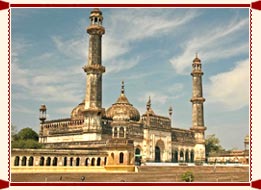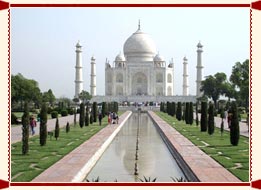 Lucknow, the city of Nawabs, has never ever lost its relevance in the Indian history and culture. The city inspires manner in a way that people who have not experienced in, yearn for it. Lucknow has always ruled as one of the most important centers of Muslim cultural influence in South Asia along with Delhi, Lahore and Hyderabad. Courtly manners, Charbagh, Qauwwali, Chikankari embroidery, Kabobs and the contributions of poets patronized by Lucknow Nawabs are well known all over.
Lucknow, the city of Nawabs, has never ever lost its relevance in the Indian history and culture. The city inspires manner in a way that people who have not experienced in, yearn for it. Lucknow has always ruled as one of the most important centers of Muslim cultural influence in South Asia along with Delhi, Lahore and Hyderabad. Courtly manners, Charbagh, Qauwwali, Chikankari embroidery, Kabobs and the contributions of poets patronized by Lucknow Nawabs are well known all over.
The history of the city is as vivid as itself. It is believed that the city has been named after Lakshman, the younger brother of Lord Rama. The city was earlier called Lakshman Pore that later turned in to Lucknow. The city rose to the prominence during the reigns of Nawabs who built numerous Palaces, Haveli, Mosques and other Monuments. The most illustrious and equally mocked upon Nawab of Lucknow is undoubtedly Nawab Wajid Ali Shah. The city later passed to East India Company after Nawabs lost the battle of Buxar in the year 1764. The city remained the capital of Awadh or Oudh province of the British and went on to become the capital Central Province and in turn Uttar Pradesh.
The city offers a range of monuments for the visitors to see and appreciate. The most important among these are Imambara. There are lots of Imambara in Lucknow but the most famous ones are Chota Imambara, Bada Imambara and Shah Najaf Imambara. These are the sites of annual 'Azadari' or mourning sessions that occur in the Islamic Month of Mohharum and called 'Asura'. The Tazia processions and Marsia sessions of the old city are trademarks of Lucknow and so are its foods.
Nowhere and I repeat, Nowhere in Asia would you find a city so synonymous to its culinary. The food culture of Lucknow has no parallels at all. The most favored and served delicacy of Lucknow are Kabobs. There is a range of it available in the old Lucknow area but the most favored destination is 'Tunda Kabob'. 'Kulcha-Nihari' is another popular dish mostly taken as breakfast. Other masterpieces include Biryani, Paya and Halim. For the vegetarians, 'Malai Kofta' and 'Tehri' are good options.
Taj Mahal History
 A visit to the Taj Mahal is worthless unless you are familiar with the history of this monument. Known as the undying symbol of love, the origin and history of Taj Mahal goes back to the early 17th Century. This wonderful piece of art in white marble was built by the fifth Mughal Emperor Shah Jahan in the memory of his beloved wife Mumtaz Mahal. Though Shah Jahan had many wives, Mumtaz Mahal was his favorite wife. She was not only a companion in good and bad times but also a sound advisor to her husband. Read on further to know about Taj Mahal history.
A visit to the Taj Mahal is worthless unless you are familiar with the history of this monument. Known as the undying symbol of love, the origin and history of Taj Mahal goes back to the early 17th Century. This wonderful piece of art in white marble was built by the fifth Mughal Emperor Shah Jahan in the memory of his beloved wife Mumtaz Mahal. Though Shah Jahan had many wives, Mumtaz Mahal was his favorite wife. She was not only a companion in good and bad times but also a sound advisor to her husband. Read on further to know about Taj Mahal history.
In the year 1612, Prince Khurram (Shah Jahan's name) married a beautiful Persian princess Arjumand Bano. She proved to be his better half and never left her husband's side in any situation. She even followed him on his military expeditions and hunting journeys. She gave him so much love that Shah Jahan was motivated to lead life in a benevolent and compassionate way. He regularly donated money and other necessities to charities and made sure that people in his kingdom never had a complaint.
While accompanying Shah Jahan on one of his camps, Mumtaz Mahal breathed her last while giving birth to their 14th child. Shah Jahan was devastated and was so heart broken that he locked himself up in a room for two years. The whole court and empire went into mourning when Mumtaz Mahal died. It is said that when Shah Jahan finally emerged after two years of mourning, his hair had turned white. Shah Jahan was determined on building the most beautiful monument as a symbol of his undying love for his wife. Thus began the construction of the Taj Mahal.
A council of the finest architects from across continents was appointed to design the Taj Mahal. The chief architect for building the monument was a Persian by the name of Ustad Isa. He alongwith his devoted pupil, Ustad Ahmed started the construction of this monument. Though the credit of designing the monument goes to Ustad Isa, the dome was designed and decorated ornately by Ismail Khan. A workforce of around 20,000 craftsmen from across the country was employed and it took a period of around 22 years to build the monument. When the monument was finally built, the grave of Mumtaz Mahal was shifted to the grave chamber in the lower part of Taj Mahal.









